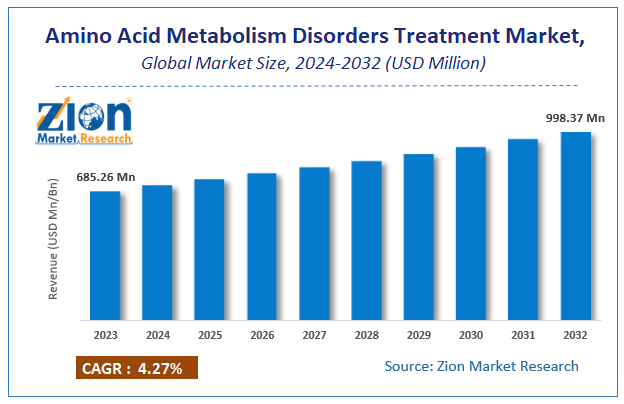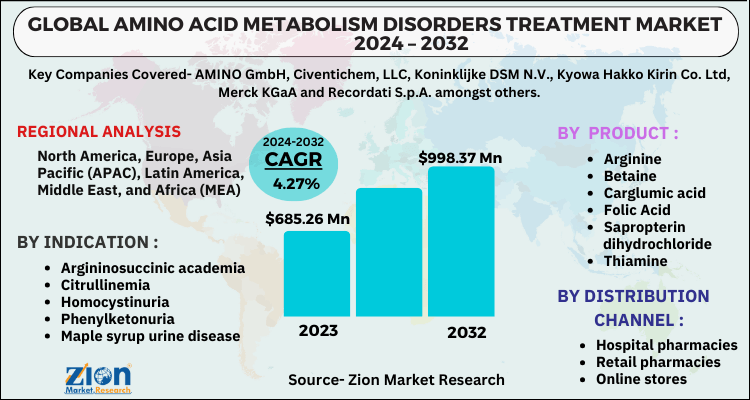Amino Acid Metabolism Disorders Treatment Market Size, Analysis, 2032

Amino Acid Metabolism Disorders Treatment Market By Indication (Argininosuccinic academia, Citrullinemia, Homocystinuria, Phenylketonuria and Maple syrup urine disease), By Product (Arginine, Betaine, Carglumic acid, Folic Acid, Sapropterin dihydrochloride, Thiamine, Vitamin B6 and B12 and Vitamin D), By Distribution Channel (Hospital pharmacies, Retail pharmacies and online stores), and By Region - Global Industry Perspective Comprehensive Analysis and Forecast, 2024 - 2032
| Market Size in 2023 | Market Forecast in 2032 | CAGR (in %) | Base Year |
|---|---|---|---|
| USD 685.26 Million | USD 998.37 Million | 4.27% | 2023 |
Amino Acid Metabolism Disorders Treatment Market: Industry Perspective
The global amino acid metabolism disorders Treatment market size was worth around USD 685.26 Million in 2023 and is predicted to grow to around USD 998.37 Million by 2032 with a compound annual growth rate (CAGR) of roughly 4.27% between 2024 and 2032. The report analyzes the global amino acid metabolism disorders Treatment market's drivers, restraints/challenges, and the effect they have on the demands during the projection period. In addition, the report explores emerging opportunities in the amino acid metabolism disorders Treatment industry.
Amino Acid Metabolism Disorders Treatment Market: Overview
The report covers forecast and analysis for the Amino Acid Metabolism Disorders Treatment market on a global and regional level. The study provides historical data from 2018 to 2022 along with a forecast from 2024 to 2032 based on revenue (USD Million). The study includes drivers and restraints for the Amino Acid Metabolism Disorders Treatment market along with the impact they have on the demand over the forecast period.
Additionally, the report includes the study of opportunities available in the Amino Acid Metabolism Disorders Treatment market on a global level. In order to give the users of this report a comprehensive view of the Amino Acid Metabolism Disorders Treatment market we have included a competitive landscape and analysis of Porter’s Five Forces model for the market. The study encompasses a market attractiveness analysis, wherein indication, product, distribution channel, and regional segments are benchmarked based on their market size, growth rate and general attractiveness.
Amino acid is the building block that allows one's body to produce proteins. Hydrogen (H), nitrogen (N), oxygen (O), and carbon (C) and others are the components present in amino acids. Nearly 500 naturally occurring amino acids have been identified, only 20 of which are evident in the genetic code, which can be further divided into innumerable ways. At least one amino acid-related metabolic disease. Metabolic diseases may occur when unusual chemical reactions take over the normal metabolic process. Moreover, the case may be that the amino acid gets into the cells. Therefore, the production of toxic material in the body is responsible for these problems.
Amino Acid Metabolism Disorders Treatment Market: Segmentation
The study provides a decisive view of the Amino Acid Metabolism Disorders Treatment market by segmenting the market based on Enzyme, Indication, Product, Distribution Channel and regions. All the segments have been analyzed based on present and future trends and the market is estimated from 2024 to 2032.
Based on Indication, the market is segmented into Argininosuccinic academia, Citrullinemia, Homocystinuria, Phenylketonuria and Maple syrup urine disease. Among these, by the end of the forecast period, phenylketonuria is predicted to emerge dominant.
Based on the Product segment, the market is bifurcated into Arginine, Betaine, Carglumic acid, Folic Acid, Sapropterin dihydrochloride, Thiamine, Vitamin B6 and B12 and Vitamin D. During the forecast period, the segment of carglumic acid will see significant growth. Carglumic acid is used to treat hyperammonemia in people with N-acetyl glutamate synthase deficiency. According to the United States Every year, approximately 30 newborns in the U.S. are diagnosed with hyperammonemia at national health institutes. Increasing hyperammonemia prevalence would fuel the market for carglumic acid over the duration of the study.
Based on the Distribution Channel segment, the market is bifurcated into Hospital pharmacies, Retail pharmacies and online stores. The distribution channel group for hospital pharmacies will have a significant share over the coming years. Hospital pharmacies typically store a large number of drugs and advanced equipment and provide hospital patients with medication. The burden of genetic disorders would increase the number of hospitalizations, thereby having a positive effect on hospital pharmaceutical development.
Amino Acid Metabolism Disorders Treatment Market: Regional Insights
The geographical segmentation comprises the current and forecast demand for North America, Europe, Asia Pacific, Latin America, and Middle East & Africa. During the forecast period, North America is expected to lead the global market. Countries like Germany, the United States, Spain, and France are expected to deliver lucrative growth opportunities to players operating in this market. After North America, Europe is projected to be the second leading country. In addition, rising nutritional management activities in the Asia Pacific provide this market with beneficial growth prospects.
Due to increased costs of amino acid supplements and patient non-compliance, the financial burden will decrease the growth of the demand for amino acid metabolism disorder care in the coming years. It is estimated that the price in the UK is around € 4,000 per year. Additionally, a lack of awareness of such disorders will negatively impact the growth of the market. The expansion of the industry will also have a negative impact on physiological stress, discomfort, inconvenience and risk of infections associated with frequent phenylketonuria injections.
Amino Acid Metabolism Disorders Treatment Market: Report Scope
| Report Attributes | Report Details |
|---|---|
| Report Name | Amino Acid Metabolism Disorders Treatment Market |
| Market Size in 2023 | USD 685.26 Million |
| Market Forecast in 2032 | USD 998.37 Million |
| Growth Rate | CAGR of 4.27% |
| Number of Pages | 230 |
| Key Companies Covered | AMINO GmbH, Civentichem, LLC, Koninklijke DSM N.V., Kyowa Hakko Kirin Co. Ltd, Merck KGaA and Recordati S.p.A. amongst others |
| Segments Covered | By Indication, By Product, By Distribution Channel and By Region |
| Regions Covered | North America, Europe, Asia Pacific (APAC), Latin America, Middle East, and Africa (MEA) |
| Base Year | 2023 |
| Historical Year | 2018 to 2022 |
| Forecast Year | 2024 - 2032 |
| Customization Scope | Avail customized purchase options to meet your exact research needs. Request For Customization |
Amino Acid Metabolism Disorders Treatment Market: Key Players
Key players within the global Amino Acid Metabolism Disorders Treatment market include:
- AMINO GmbH
- Civentichem LLC
- Koninklijke DSM N.V.
- Kyowa Hakko Kirin Co. Ltd
- Merck KGaA and Recordati S.p.A.
The report segments the global Amino Acid Metabolism Disorders Treatment market as follows:
By Indication Segment Analysis
- Argininosuccinic academia
- Citrullinemia
- Homocystinuria
- Phenylketonuria
- Maple syrup urine disease
By Product Segment Analysis
- Arginine
- Betaine
- Carglumic acid
- Folic Acid
- Sapropterin dihydrochloride
- Thiamine
- Vitamin B6 and B12
- Vitamin D
By Distribution Channel Segment Analysis
- Hospital pharmacies
- Retail pharmacies
- Online stores
By Regional Segment Analysis
- North America
- U.S.
- Europe
- UK
- France
- Germany
- Asia Pacific
- China
- Japan
- India
- Latin America
- Brazil
- Middle East and Africa
Table Of Content
Methodology
FrequentlyAsked Questions
Amino acid is the building block that allows one's body to produce proteins. Hydrogen (H), nitrogen (N), oxygen (O), and carbon (C) and others are the components present in amino acid.
According to a study, the global amino acid metabolism disorders treatment market size was worth around USD 685.26 million in 2023 and is expected to reach USD 998.37 million by 2032.
The global amino acid metabolism disorders treatment market is expected to grow at a CAGR of 4.27% during the forecast period.
North America dominated the global amino acid metabolism disorders treatment market in 2023.
Some key players of the global amino acid metabolism disorders treatment market AMINO GmbH, Civentichem, LLC, Koninklijke DSM N.V., Kyowa Hakko Kirin Co., Ltd, Merck KGaA and Recordati S.p.A. amongst others.
RelatedNews
HappyClients
Zion Market Research
Tel: +1 (302) 444-0166
USA/Canada Toll Free No.+1 (855) 465-4651
3rd Floor,
Mrunal Paradise, Opp Maharaja Hotel,
Pimple Gurav, Pune 411061,
Maharashtra, India
Phone No +91 7768 006 007, +91 7768 006 008
US OFFICE NO +1 (302) 444-0166
US/CAN TOLL FREE +1 (855) 465-4651
Email: sales@zionmarketresearch.com
We have secured system to process your transaction.
Our support available to help you 24 hours a day, five days a week.
Monday - Friday: 9AM - 6PM
Saturday - Sunday: Closed






